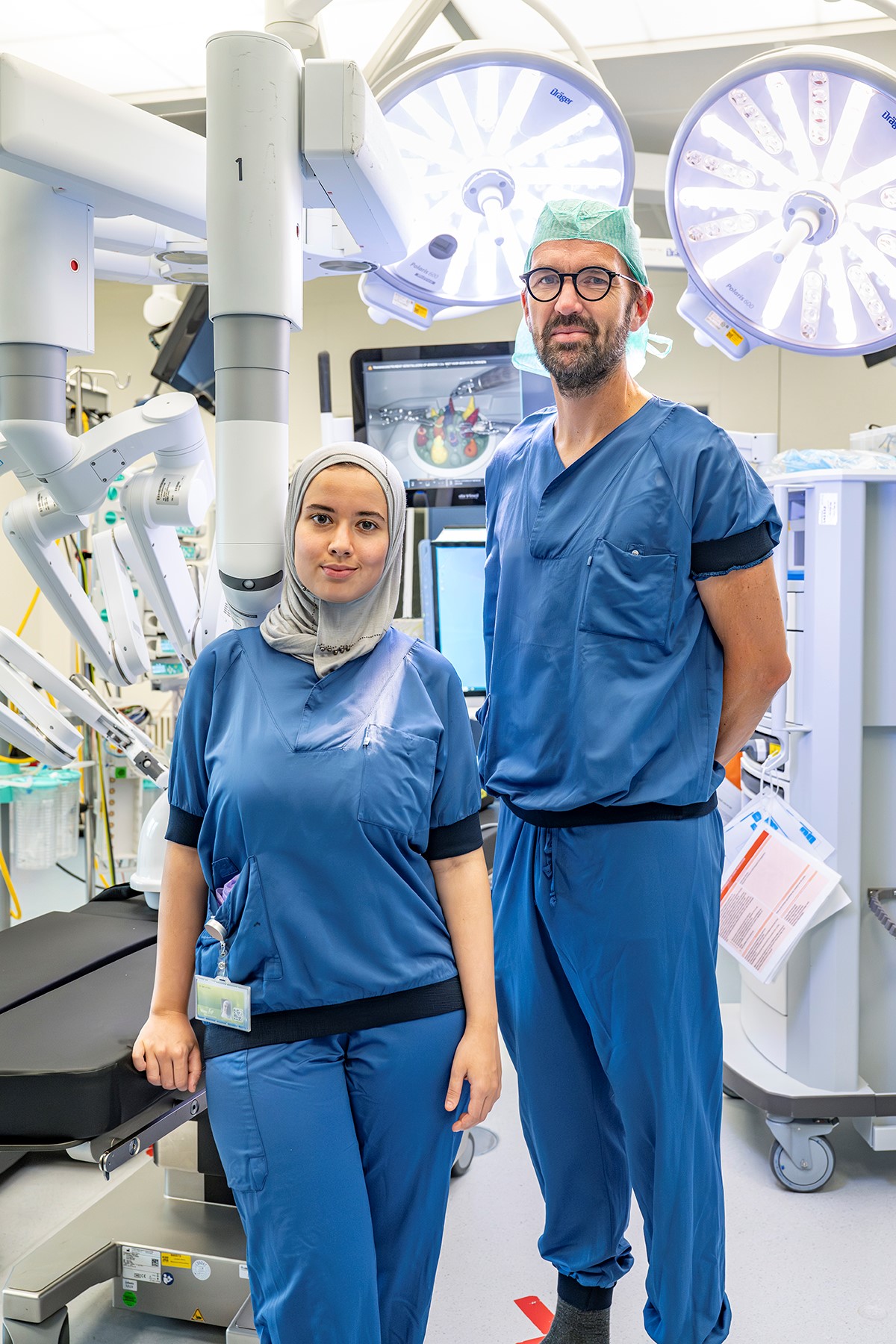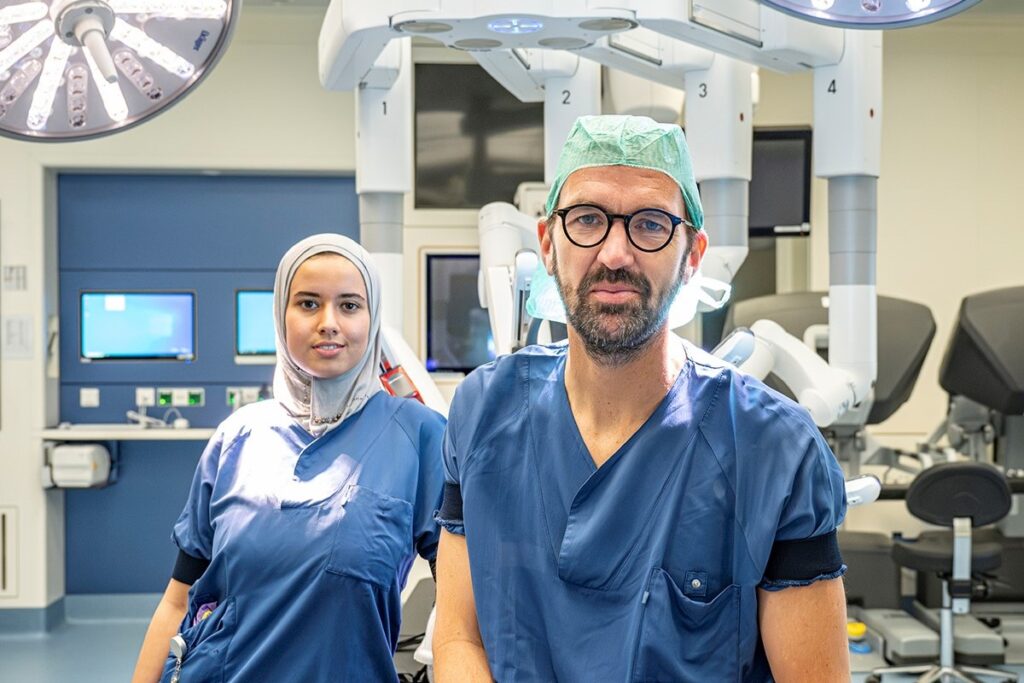According to abdominal surgeon and lead researcher Freek Daams, the new method will help to prevent so-called seam leaks. “A classic complication that can occur during bowel surgery. When we remove a piece of bowel and put the two ends back together, there may be a leak at the seam. It happens to every surgeon from time to time, no matter how good they are. But for the patient, it’s a horrible complication that can even be fatal.”
Predicting the future
Despite Daams’ efforts in recent years to improve existing surgical techniques to reduce the risk of seam leaks, he also began to work on an alternative approach. “Being able to predict who this will and will not happen to is much more effective than trying to prevent it from happening. With machine learning, a subset of AI, we now have the right tool to do just that. Our computer model is able to detect patterns in a patient at a very early stage during surgery, and the surgeon can then use that information to choose the best procedure.”
For colon cancer patients, there are two options: the surgeon can either remove a portion of the bowel, which carries a risk of seam leakage, or remove the entire bowel and create a stoma: an opening in the abdomen connected to a bag that collects stool. If the model predicts that the patient has a high risk of leakage, the surgeon may opt for a stoma. “But that does come at the expense of quality of life, because a bowel stoma is quite an adjustment”, says Daams. “Still, a stoma is always better than a seam leak.”
Less drastic precautions
The interesting thing about the predictive model is that even for those patients not at risk of leakage – the vast majority – there is much to gain. Because the model is highly accurate: in more than 97 percent of cases, its predictions turn out to be correct. “That means you can spare a lot of people the drastic precautions that we’re now taking for everyone. We no longer need to construct a temporary stoma to reduce the risk of leakage, and we can discharge patients earlier.”
‘At the end of the day, a human has to make the call’
On 10 October, the model will be used in the operating theatre for the first time. During this trial run, the research team will test the program to see if it’s effective and user-friendly. “It’s important that it works in real time – the model needs to be able to adjust its prediction based on data about the patient’s blood pressure and blood loss during surgery”, Daams explains. “The computer gets that data from the electronic patient file. The more information the model can process, the more accurate its prediction becomes. It’s also vital that the computer can complete its calculations and produce a prediction within a few minutes, so that the operation is not delayed.”
World’s first
A computer model like the one developed by this research team, which uses data from the patient’s file to generate a prediction during surgery, does not yet exist anywhere else in the world. As the model is still in the testing phase, the surgeon leading the trial operation in October will not yet take the program’s predictions into account. Daams expects that the first testing phase will require about ten to fifteen operations. “Next year, we’ll be studying the clinical impact of the model at hospitals across the Netherlands to collect more data on how it can actually help surgeons and patients”, says Daams.
Text continues after the image.

Patients are confident
PhD student Sara Ben Hmido, who is coordinating the pilot study, conducted a survey earlier this year to find out if patients would be comfortable with an AI model in the operating theatre. “The results show that they have confidence in this tool, because they find it reassuring that the model is more experienced than the surgeon. The model has been trained using data from 5,000 operations, which is far more than a surgeon could ever do.” Daams adds that patients view the AI model as any other tool at the surgeon’s disposal. “Ultimately, the surgeon decides how to use this particular tool, just as with a stapler, suture or CT scan. The thinking seems to be: if the surgeon believes that using an AI model is better for me as a patient, then they should use it.”
Daams explains that the computer model also provides additional information on why it makes specific predictions. This is done in such a way that the surgeon can still influence the outcome. “For example, if the model predicts that a patient is at risk of leakage because their body temperature is too low and their glucose levels are spiking, you can decide to turn on the heating and inject insulin. The surgeon has more to go on during the operation.”
Ethical considerations
Using a predictive AI model in the operating theatre also raises ethical questions. Can you justify its use if the model is wrong? What happens if seam leakage occurs contrary to the program’s prediction? “That’s a good point”, says Daams. “First of all, you need to get the patient’s consent. And we’re also seeing that surgeons don’t want to use the AI model until they’re convinced it’s going to be effective in their hospital. The surgeons have to believe in this method. I also think it’s important to minimise the risk of bad outcomes. So if someone does have an unexpected leak, we make sure we spot it as soon as possible, for example by monitoring the patient remotely after surgery. The risk involved is much lower than the current risk, but you still want to make the operation as safe as possible.”
Finally, Daams stresses that how a surgeon responds to the model’s predictions will depend on the context. “Some surgeons have a very low leakage rate, so then it makes sense to opt for a seam more often. The patient’s condition also factors in: a young, healthy patient may bounce back quickly after a seam leak, whereas an 80-year-old patient in poor condition is unlikely to survive. For those patients, a stoma would be a better option. At the end of the day, decisions are made on a case-by-case basis, and a human has to make the call.”
Translation: Taalcentrum-VU
